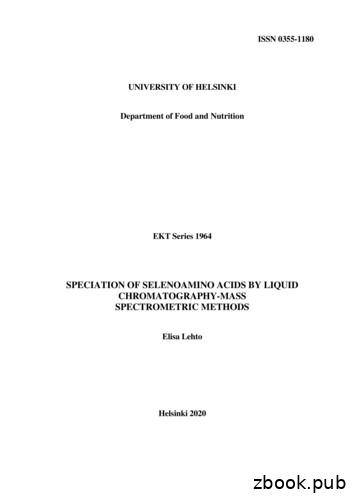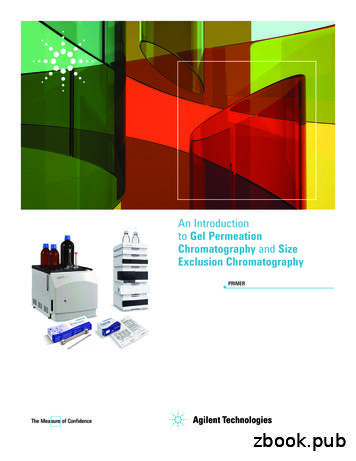Gas Chromatography - Towson University
Gas Chromatography Like other methods of chromatography, a partitioning of molecules must occur between the stationary phase and the mobile phases in order to achieve separation. This is the same equilibrium that is seen between the stationary phase and mobile phase in column chromatography or thin-layer chromatography. Disadvantage: Destructive Technique – once analyzed by GC, the sample is “lost” Advantages: Only needs 1 µL to analyze a sample mixture Can analyze any compound that can be vaporized Cheapest, fastest and easiest method for the separation, identification and analysis of volatile compounds Gas Chromatography: 1. Stationary Phase – the adsorbent inside the Column Solid Support – Steel, Copper or Glass tubing Adsorbent – liquid coating inside tubing of high-boiling hydrocarbons, waxes, silicone oils, polymeric esters, etc. Based on polarity and molecular weight, the compounds being separated adhere to the column’s adsorbent to varying degrees. The adsorbent in the column determines the maximum limit to how hot the column can be heated. Too hot and you can boil away the adsorbent, right out of the column! 2. Mobile Phase – the Gas Gases commonly used for GC would include inert gases like Helium, Nitrogen or Argon. Gas Chromatography essentially separates compounds based on their boiling points, a factor that is affected by polarity and weight of the compounds. Lower boiling compounds are those that are lightest in weight and least polar and travel the fastest through a GC column, spending more time in the mobile phase, less time “stuck” to the stationary phase, taking less time to pass through the detector. Example: Compound A has a boiling point of 50ºC and Compound B has a boiling point of 105ºC. Which one will vaporize fastest? Compound A Which one will spend more time in the mobile phase? Compound A
Which one will come out of the GC fastest? Compound A Below is a schematic “cartoon” of the process: red compound is Compound A (BP 50oC) and blue compound is Compound B (BP 105oC) injection port column (contains stationary phase) needle To Review: First, a needle is used to inject the liquid (or dissolved solid) into the Injection port, where the liquid solution is vaporized. Then the gas (mobile phase) picks up the two compounds and moves them into the column. The higher boiling compound (BLUE) begins to adhere more to the sides of the column while the lower boiling compound (RED) stays vaporized and in the mobile phase, moving through the column. By the end of the process, the lower boiling compound is moving out of the column separated from the higher boiling compound and into the detector to be analyzed by the computer system. 2
There are FIVE factors that affect the separation of compounds via GC. The first three are factors that cannot be changed/manipulated. 1. Column Length – longer columns provide more time during which the partitioning and thus separation may occur, which is needed especially for separations of compounds with similar functional groups and weights (i.e. BP). 2. Choices of Packing Material – the adsorbent can be non-polar or polar depending on what you choose. Cannot be changed without purchasing a whole other column. 3. The Boiling Point of the Compound – the closer the boiling points are, the more difficult they will be to separate. Typically determined by molecular weight and functional group (polarity). 4. Gas Flow Rate – Determines the amount of time a compound may spend in the mobile phase. Too fast: no time to develop the equilibrium required – no partitioning and the compounds rush through the column together, not separating but forming thin, narrow overlapped peaks. gas too fast? Too Slow: first compound may not have moved forwards adequately to complete the separation before the second one begins to move. Very broad and still overlapped peaks. gas too slow? 5. Oven temperature: Determines the temperature of the column and ultimately the amount of time a compound may remain vaporized during the GC analysis. Extremes: -too high will destroy the column by boiling off the adsorbent itself from inside the column -too cool will result in the compounds condensing inside the column and never coming out. Results: 3
Too hot: all the compounds will vaporize and be carried rapidly through the column, with no partitioning effect. Thin, narrow peaks, still overlapped in the middle. Oven too hot? Too cool: compounds may condense more than they should, spending too much time in the stationary phase. The first compound may adhere too much and not be completely out of the column prior to the second one coming out of the column. Broad and overlapped peaks as a result. Oven too cool? Two Types of Analysis: 1. Qualitative Analysis – Identification of Compounds To identify compounds using GC: Under identical conditions, the same compound will always travel at the same speed, taking the same time to be detected. Identical conditions means running the standard compounds during the same interval as the analysis of the unknown. Should you turn off the GC or have to reset some parameter, you must begin the comparative analysis all over again! Retention time: (similar to Rf values for TLC): Amount of time it takes for the compound to travel through the column, from the point of vaporization to the detector. Ex. Retention Times: Compound X 3.1 minutes Compound Y 4.8 minutes Compound Z 5.3 minutes Now compare Unknown Compound Q, run under identical conditions as X, Y and Z. Q has a retention time of 3.1 minutes. Which compound is it? X 4
2. Quantitative Analysis – Determination of Relative Amounts of each Compound (ratio of compounds) Step 1: Calculate the area under the peaks using the equation: Area (height of peak) x (width at half the height) width at 1/2 ht B C height height A width at 1/2 ht D First Peak: A x B Second Peak: C x D Assume AxB 20 and CxD 5 so the total of the two areas is 25. Step 2: Calculate the Percent Composition (Relative Amounts) Take each individual area and divide by sum total of all areas x 100. Should add up to 100. Percent Composition First Peak: 20/25 x 100 80% Percent Composition Second Peak: 5/25 x 100 20% Complete the Data Analysis: 1. Make a separate table summarizing the relative peak areas and retention times for each peak in the three GC traces. Note that there should be two peaks per GC trace - one corresponding to ethyl acetate and one corresponding to n-butyl acetate. If you have a third peak, then you will need to calculate the percent composition based on only the two peaks we expected to have to analyze. See #2 below. 5
GC Trace #2 Retention Time Relative Peak Area Percent Composition Ethyl Acetate Butyl Acetate GC Trace #3 Retention Time Relative Peak Area Percent Composition Ethyl Acetate Butyl Acetate 2. The percent composition is calculated by first determining the total area of the peaks you are analyzing. To do so, add together the relative peak areas for each of your applicable peaks. Then finish calculating the percent composition for each ester by dividing each individual area by the total area you just calculated. Multiply by 100 to obtain your answer in a percentage. 6
Gas Chromatography Like other methods of chromatography, a partitioning of molecules must occur between the stationary phase and the mobile phases in order to achieve separation. This is the same equilibrium that is seen between the stationary phase and mobile phase in column chromatography or thin-layer chromatography. .
2.3.1 Liquid chromatography (LC) 20 Size-exclusion chromatography (SEC) 20 Ion-exchange chromatography (IEC) 22 Reversed-phase chromatography (RP) 23 Reversed-phase ion pairing chromatography (RPIP) 24 2.3.2 Gas chromatography (GC) 25 2.3.3 Electrophoretic techniques 25 2.3.4 Isotope dilution analysis (IDA) 26 3 EXPERIMENTAL RESEARCH 27 Aims 27
Towson University - 8000 York Rd, Towson MD 21252 - 410- 704- 2171 - towson.edu/procurement . ADMISSIONS CUSTOMER RELATIONSHIP MANAGEMENT SOFTWARE . PROJECT NO. TU-2223 . Prospective bidders/offerors who obtained this document from the university's website, e- Maryland Marketplace, or . B. ISSUING OFFICE AND PROCUREMENT OFFICER .
The Towson University Office 365 portal is the gateway to access the Microsoft online web apps as well as your personal OneDrive (cloud storage). Signing In 1. Open your preferred web browser and navigate to office.towson.edu. 2. Type your full Towson University email address or NetID and password in the appropriate fields and then click
RepoRT CaRd. Towson University is a highly selective liberal arts campus of 21,000 students located on 300 acres in Towson, the county seat of Baltimore County, Maryland. Founded in 1866, Towson offers programs on .
Talent Show Contract 10 11 TOWSON HIGH SCHOOL The Towson Pride V O L U M E 1 , I S S U E 2 3 GIVE US YOUR INPUT! This week, Baltimore County Public Schools launched the BCPS 2014 Stakeholder Satisfaction Survey. This survey provides you with the opportunity to give us feedback about Towson High School and Baltimore County Public Schools.
Chromatography 481 27.4.2 Partition (Liquid–Liquid) Chromatography 482 27.4.2.1 Introduction 482 27.4.2.2 Coated Supports 483 27.4.2.3 Bonded Supports 483 27.4.3 Ion-Exchange Chromatography 483 27.4.4 Size-Exclusion Chromatography 485 27.4.5 Affinity Chromatography 488 27.5 Analys
There are many forms of chromatography, but two are very common and well known to all analytical scientists and serve to illustrate the diversity of analytical techniques. These are gas chromatography (GC) and liquid chromatography (LC). GPC/SEC is a form of LC. These techniques are described in brief below. Gas chromatography
Auditing and Assurance Services, 15e (Arens) Chapter 9 Materiality and Risk Learning Objective 9-1 1) If it is probable that the judgment of a reasonable person will be changed or influenced by the omission or misstatement of information, then that information is, by definition of FASB Statement No. 2: A) material. B) insignificant.























